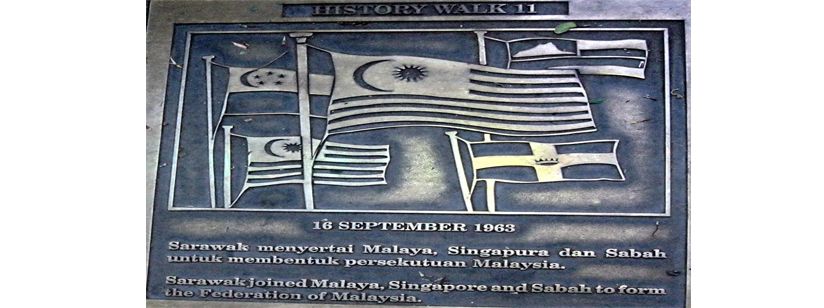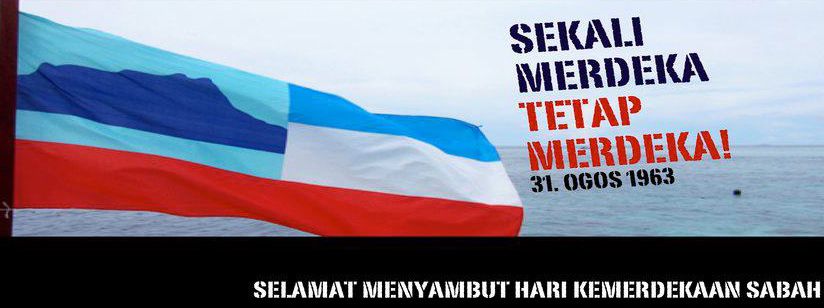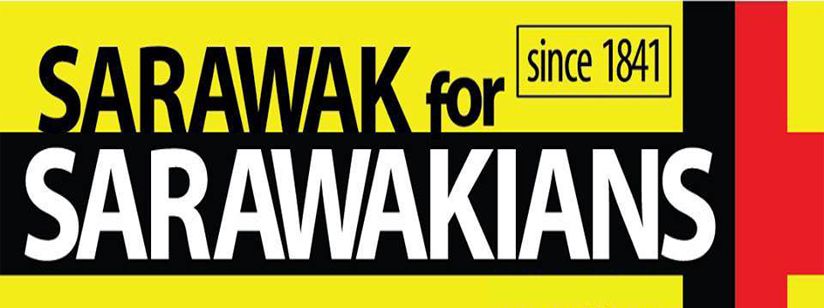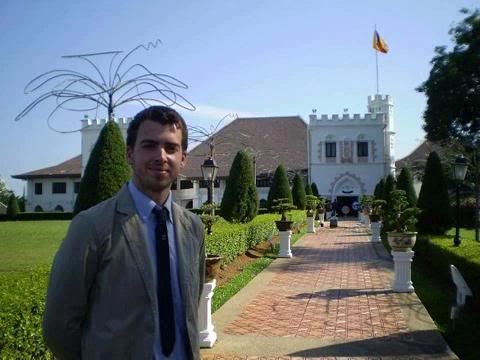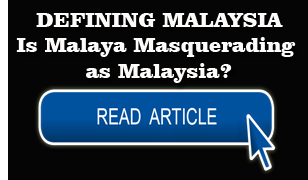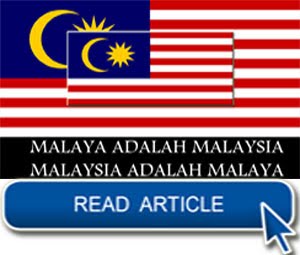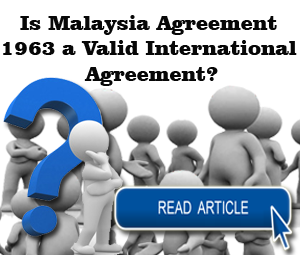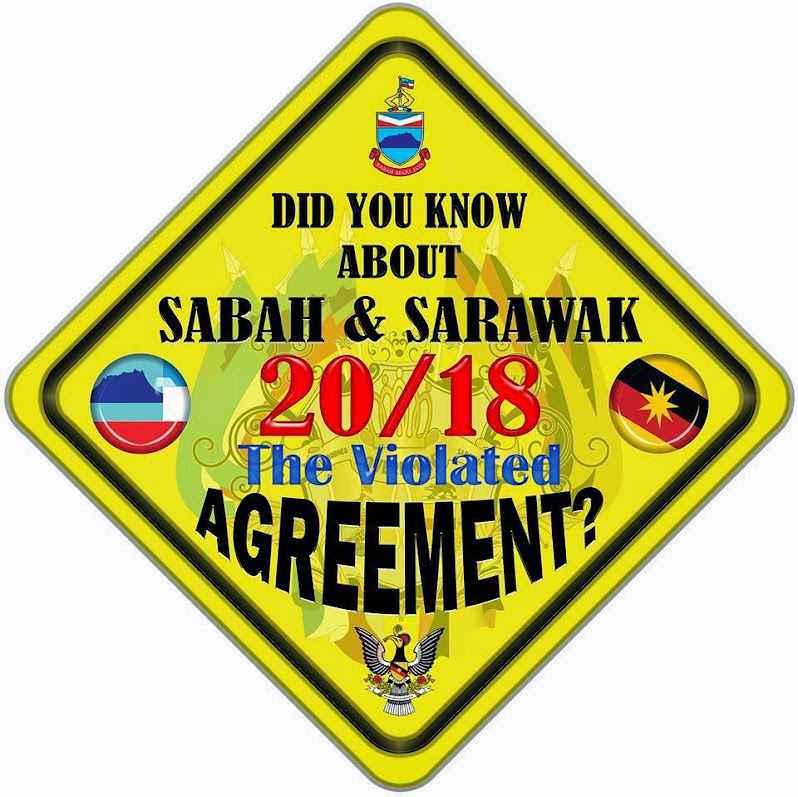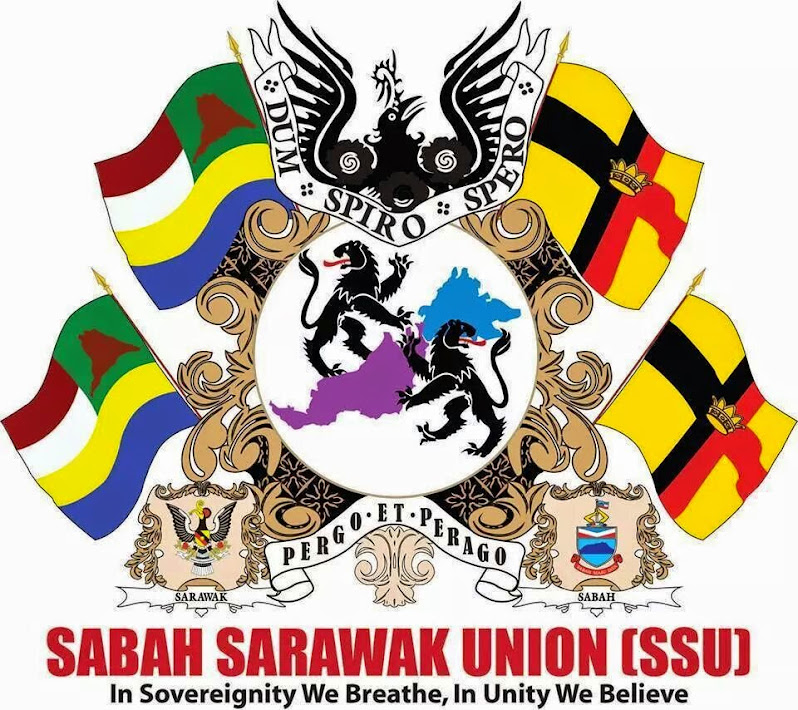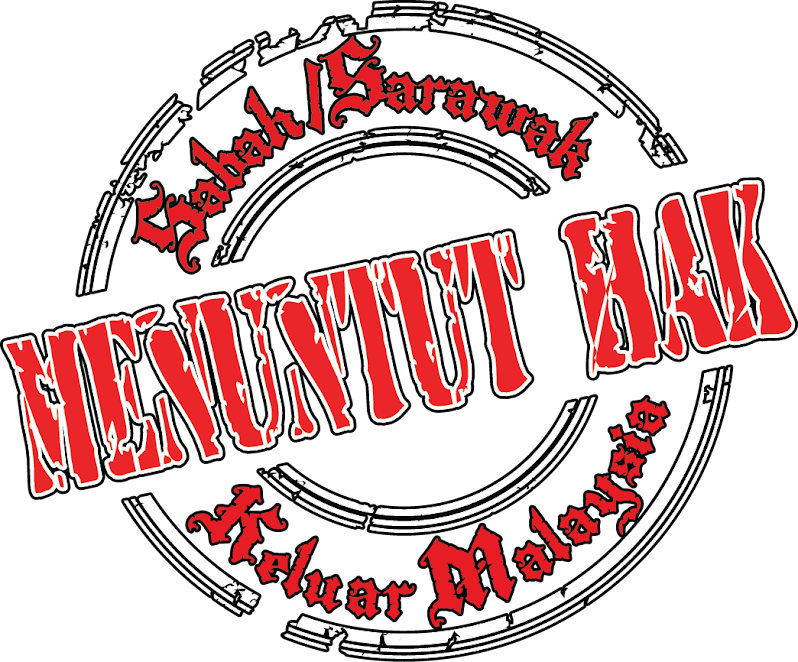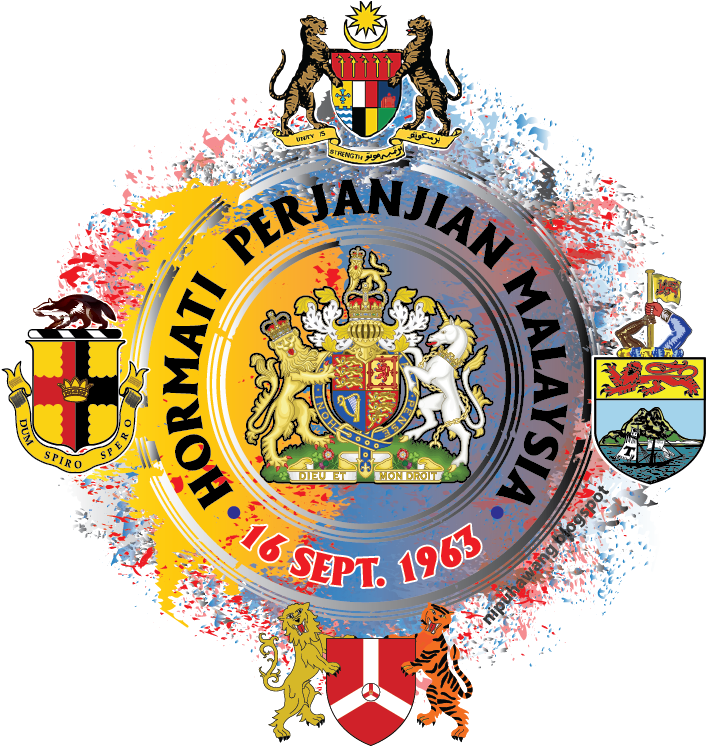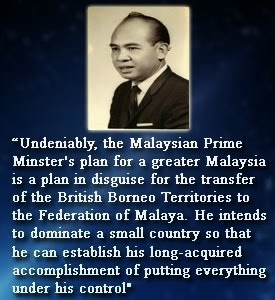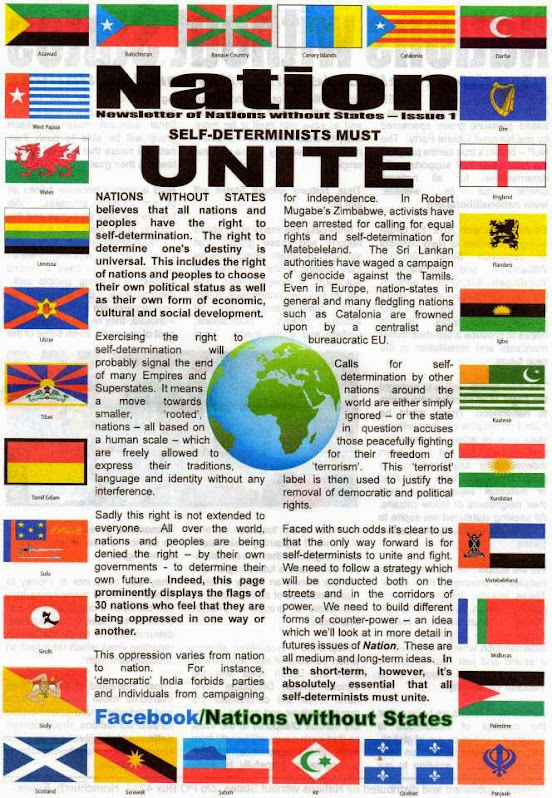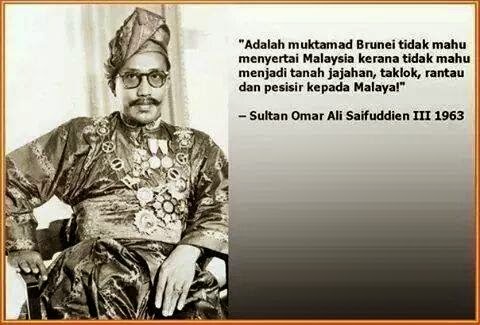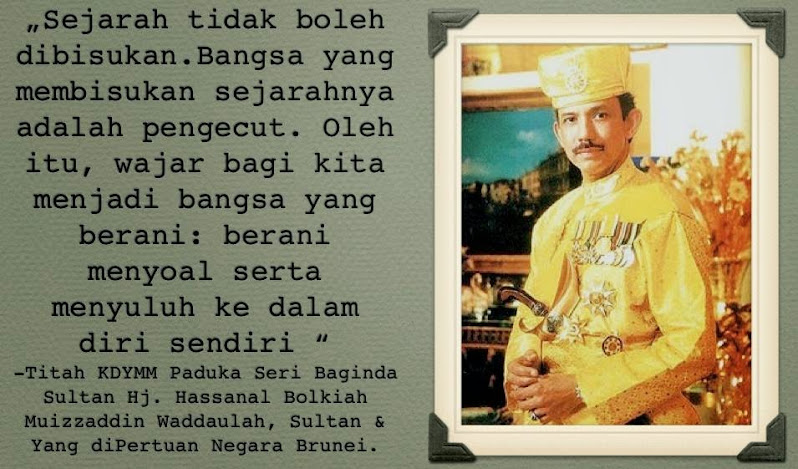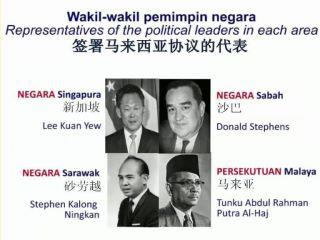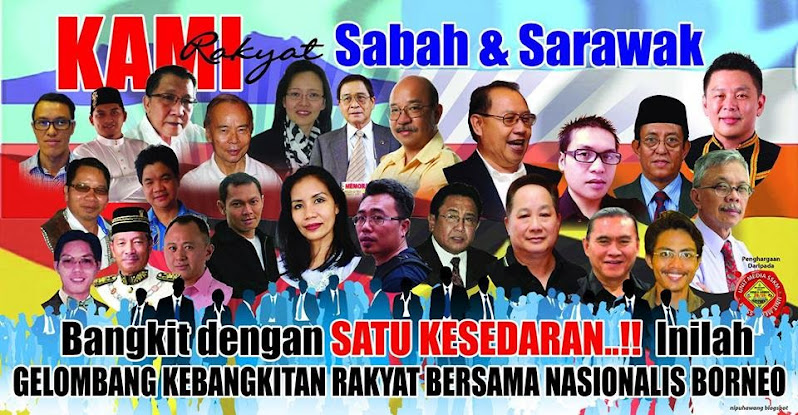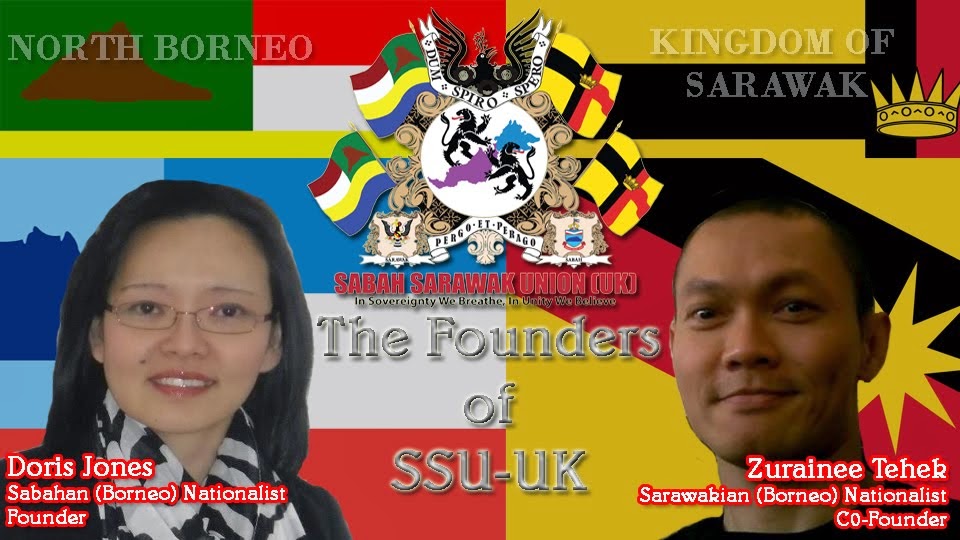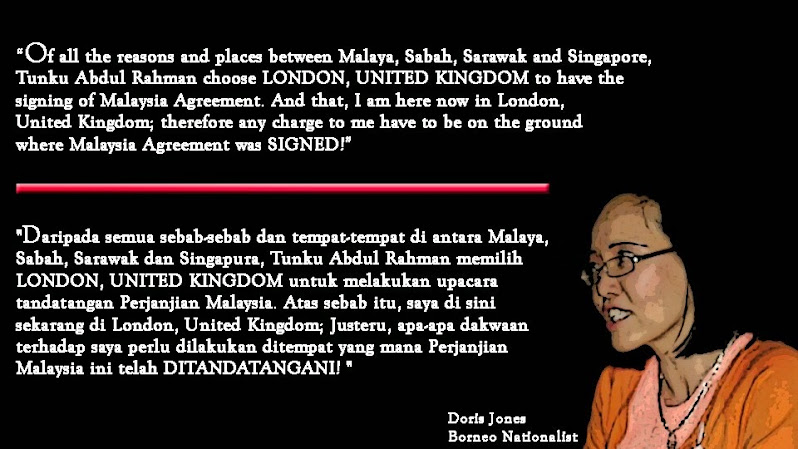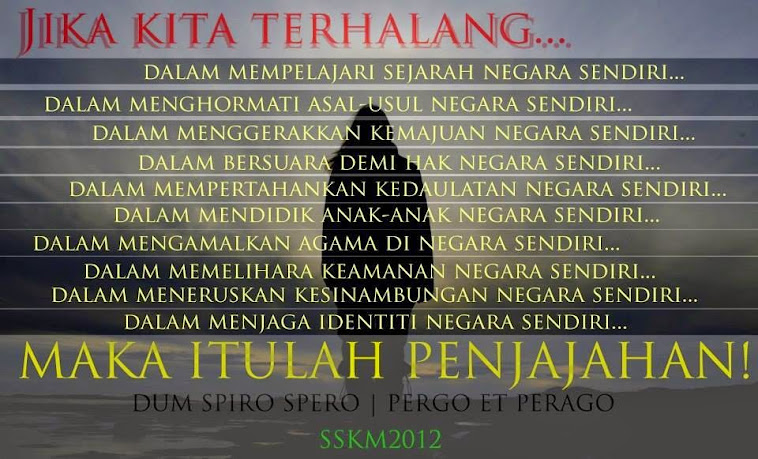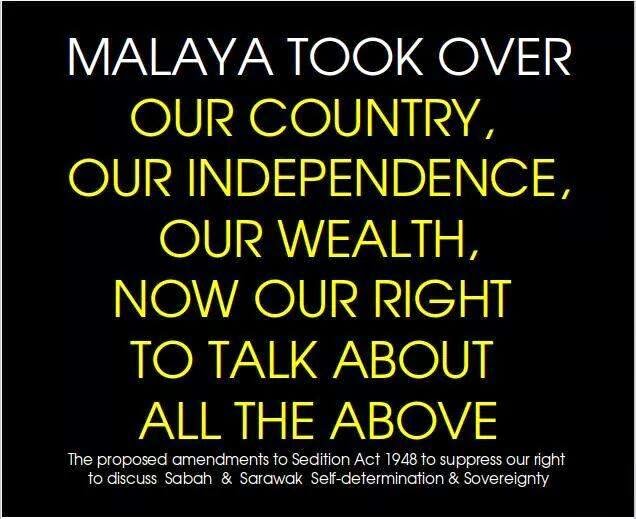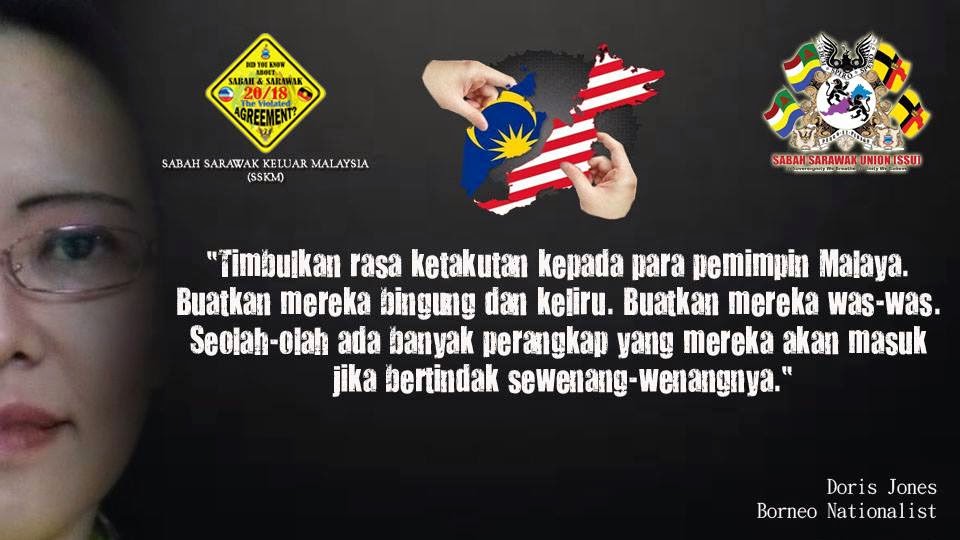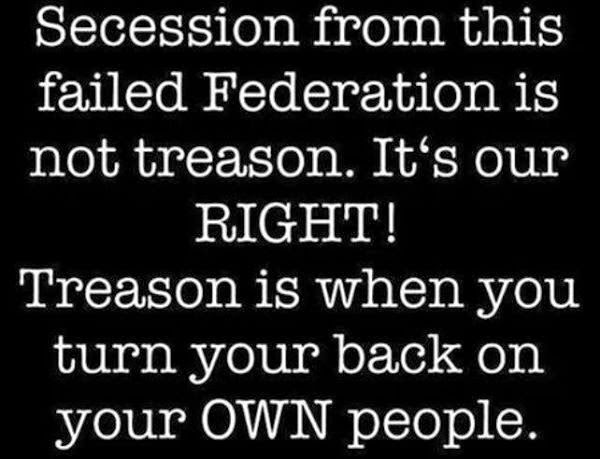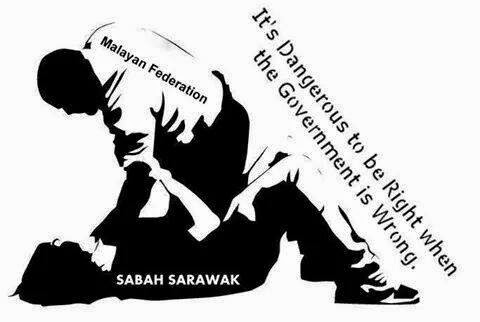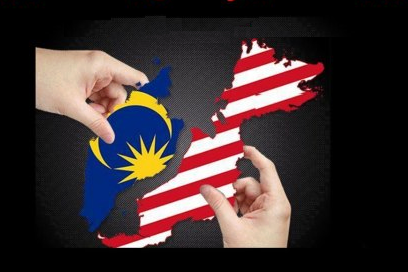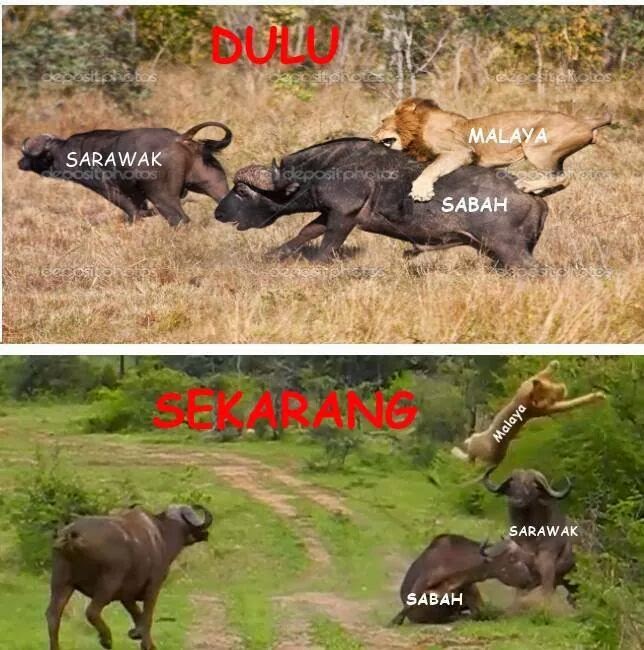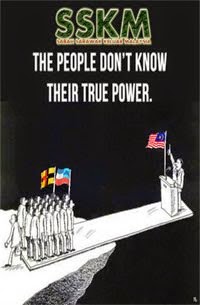Thursday 13 November 2014
Thursday, November 13, 2014
Agreement of Malaysia
,
Exposing the Truth
,
Fact
,
Federation of Malaysia 16 September 1963
,
History
,
International
,
Nationalist
,
Sabah
,
Sarawak
,
Zainal
2
comments
Defining Malaysia: Is Malaya masquerading as Malaysia?
Is Malaysia a sovereign and independent country? Or is it just the Federation of Malaya masquerading as Malaysia. After 51 years it is amusing that such a question still exists, after 51 years of Nation Building the issues of identities should have been resolved long ago – it is really most unfortunate Malaysia today still has the issues of its identity unresolved. This is much more serious than facing the mid-life crisis, handled wrongly it may become a full blown problem which may disintegrate the whole nation.
According to Article 160 of the Malaysia Constitution “the Federation” means the Federation which was established through the Federation of Malaya Agreement 1957. However, Article 1(2) of the Malaysia Constitution says the states of the Federation shall be Johore, Kedah, Kelantan, Malacca, Negeri Sembilan, Pahang, Penang, Perak, Perlis, Sabah, Sarawak, Selangor and Terengganu. The problem is not about the 11 States that made up the Federation of Malaya, the problem is in the 2 other Federations – the Federation of Sabah and Sarawak. This is because the Federation of Sabah and Sarawak formed the Federation of Malaysia through the Malaysia Agreement 1963.
Putting Sabah and Sarawak as the member States of the Federation of Malaya means that Sabah and Sarawak were bound by the Federation of Malaya Agreement 1957 when the legal documents were very clear Sabah, Sarawak and the Federation of Malaya formed the Federation of Malaysia based on the Malaysia Agreement 1963. As the result, who is Malaysia? – is it the Federation of Malaya masquerading as Malaysia? Or that Malaysia is actually the Federation of Malaya? Is Sabah and Sarawak is part of the 3 Federations that establishes the Federation of Malaysia or Sabah and Sarawak is part of the 13 States?
Whichever perspective is taken to answer this simple question Malaysia as a Nation will no longer be the same. If it is Malaya masquerading as Malaysia, then Sabah and Sarawak are free to leave the union. If the Federation of Malaya is actually part of Malaysia as agreed under the Malaysia Agreement 1963, then States of the Federation such as Kelantan, Terengganu, and Johor etc. are free to leave because they are no longer bound to the union by the Federation of Malaya Agreement 1957.
Realizing this impasse this paper is an attempt to examine and should be analyse the reason for having this identity crisis and the possible solutions that can be adopted to resolve the issues.
Malaysia was formed in 1963 via the Malaysia Agreement which was signed by representative amongst the United Kingdom, the Federation of Malaya, North Borneo (Sabah), Sarawak and Singapore on the 9 July 1963. The formation of the new Federation to be called Malaysia was specific and very clear in the Malaysia Agreement 1963. Article 1 of the Malaysia Agreement says:
Article I
The Colonies of North Borneo and Sarawak and the State of Singapore shall be federated with the existing States of the Federation of Malaya as the States of Sabah, Sarawak and Singapore in accordance with the constitutional instruments annexed to this Agreement and the Federation shall thereafter be called "Malaysia" (Emphasis added).
In this Article “the Federation is called Malaysia” is formed by this agreement. This means that it is “the Federation” that is called Malaysia; it is not just a change of name from Malaya to Malaysia but the whole Federation which was called “the Federation of Malaya to the Federation of Malaysia”. Therefore the new Nation is to be called the Federation of Malaysia and NOT just simply being called Malaysia.
The Malaysia Agreement also contained “constitutional instruments” contained in its Annex A. These are constitutional arrangements discussed and agreed in the Inter-Governmental Committee report and are changes that were supposed to be made to the existing Federal constitution of Malaya. Annex A is called the Malaysia Bill because these changes were supposed to be tabled and passed by the parliament of the Federation of Malaya. This is different from the Constitution of North Borneo (Sabah) – Annex B, Sarawak – Annex C and Singapore – Annex D. The Constitution of the North Borneo, Sarawak and Singapore was passed by Order in Council made with the consent of Queen Elizabeth II of the United Kingdom and NOT by the Federation of Malaya’s parliament.
It is very unfortunate that the changes made to the Federation of Malaya’s Constitution were never made sincerely and thoroughly as the base for building the new Nation. There are interpretations to the Constitution which may be purposely overlooked. This oversight is no excuse, because the Nation has existed for the last 51 years, yet no appropriate changes was made to reconcile any inconsistencies.
Imagine the implications to so many agreements that have been signed as the Federation of Malaysia, so many laws that have been passed by the Malaysia Parliament, and so many international conventions and treaties ratified as Malaysia. Instead of making the necessary changes as in accordance to the Malaysia Agreement 1963, certain interpretation was never altered accordingly. As such it is the definition of “the Federation” which is today creating the crux of the identity crisis for Malaysia. The definition made it appear that the Federation of Malaya is masquerading as Malaysia – the reality is that Malaysia is actually Malaya which was formed by the Federation of Malaya Agreement 1957 and NOT formed by the Malaysia Agreement 1963.
The Malaysia Constitution which was reprinted and updated up to 2010 states the following:
Article 1(1) The Federation shall be known, in Malay and in English, by the name Malaysia.
Article 1(2) The States of the Federation shall be Johore, Kedah, Kelantan, Malacca, Negeri Sembilan, Pahang, Penang, Perak, Perlis, Sabah, Sarawak, Selangor and Terengganu.
However in Article 160 interpretation of the Malaysia Constitution define “the Federation” as follows:
“the Federation” means the Federation established under the Federation of Malaya Agreement 1957.
If this is the meaning of “the Federation” then Sabah and Sarawak should NOT be included as the “States of the Federation” because Sabah and Sarawak did not agree to be a part of the Federation of Malaya in accordance to the Federation of Malaya Agreement 1957 – Sabah and Sarawak agreed to form the Federation of Malaysia as how it was arranged by the Inter-Governmental Committee (IGC) Report and the Malaysia Agreement 1963.
To simply include Sabah and Sarawak as part of the “States of the Federation” is not just erroneous but legally wrong. It is implicit that Sabah and Sarawak is part of the 13 states instead of 3 states that formed Malaysia, however, any Sabahan and Sarawakian will insist that Malaysia is a Federation of 3 nations. It is a fact that the Federation of Malaya Agreement 1957 and the Malaysia Agreement 1963 are two separate and dissimilar documents. The Federation of Malaya Agreement 1957 was a merger of the Federated Malay States, the Un-federated Malay States and the Strait Settlements into one union – the Federation of Malaya.
The Malaysia Agreement 1963 is an agreement between the United Kingdom, the Federation of Malaya (which is a union of 11 states), North Borneo (Sabah), Sarawak and Singapore. Structurally this is a Union on top of a Union; it is not making of the Federation of Malaya to become the Federation of Malaysia.
IF the structure of Malaysia was constructed in the original spirit of the Malaysia Agreement 1963 then, there should be two levels of the Federation. The Federation of Malaya consisting of the 11 States and formed by the Federation of Malaya Agreement 1957 and the Federation of Malaysia made up of the Federation of Malaya, Sabah and Sarawak and formed by the Malaysia Agreement 1963. Perhaps in this way there are no confusion, no misinterpretation and no dissents in the effort for Nation building.
However, instead of establishing two layers of the Federation, the Federation of Malaya was simply elevated and made itself into the Federation of Malaysia. This solution, instead of establishing a proper starting point for Nation building, creates so much confusion, misinterpretations and dissents, especially for the Borneo States. This is based on the anxiety and fear of the Borneo people that the Federation of Malaya is colonizing them. This also vindicates the warnings of Sabah and Sarawak’s forefathers about Malaya’s imperialist tendencies and their mechanization and manipulations over Sabah and Sarawak people. As the result, this provides credibility to the claims made by dissidents in Sabah and Sarawak today about broken promises, disenfranchisements and marginalization of the people by Malaya – all these are pointing out that Sabah and Sarawak is Malaya’s colonies.
But most importantly when the structure did not reflect Union on top of a Union in the formation of Malaysia its implication to the laws of the Federation which were passed for the last 51 years may perhaps not be enforceable in Sabah and Sarawak.
The implication of this assertion is catastrophic. This refers to the Laws of the Federation containing word such as – “the Federation”, “the Government of the Federation”, “the Federal Government”, and “the Malaysia Government” etc. How is it possible to make use of the laws made by the Federation of Malaya applicable to the Federation of Malaysia?
Erasing the contending interpretation is not an option
To resolve this impasse, it may not be as simple as replacing the existing interpretation in Article 160 from “the Federation of Malaya Agreement 1957” to the “Malaysia Agreement 1963”. The solution may look simple but legally such action may no longer bind the original 11 States to the Federation of Malaya which is masquerading as the Federation of Malaysia. This may mean that the 11 States especially Kelantan and Terengganu may take this opportunity to break away from the Federation of Malaya and start their own sovereign and independent country using the Oil and Gas as their main source of income. Johor may want to be on its own especially when deciding their relationship with Singapore and Pahang may want to explore and exploit its own Oil and Gas fields. The Federation of Malaya may be left with States such as Malacca, Negeri Sembilan, Selangor, Perak, Kedah, Pulau Pinang and Perlis – a power hungry industrial belt which is facing a bleak economic future.
What is the reason the definition of “the Federation” was not changed in the Malaysia Constitution as implicit in the Malaysia Agreement 1963? Certainly it is not just a simple oversight; perhaps it was done on purpose because on the eve of the formation of Malaysia, the Kelantan government challenged the Prime Minister of Malaya, Tunku Abdul Rahman in court on the basis that Kelantan was never consulted over the decision to form Malaysia. According to Kevin Tan1 the Kelantan Government argued that both the Malaysia Agreement and the Malaysia Act were not binding on Kelantan on the following grounds:
(a) that the Malaysia Act in effect abolished the Federation of Malaya and this was contrary to the 1957 Federation of Malaya Agreement;
(b) that the proposed changes required the consent of each of the constituent states of the Federation of Malaya – including Kelantan – and this had not been obtained;
(c) the Sultan of Kelantan should have been a party to the Malaysia Agreement, but was not;
(d) a constitutional convention existed that required the Malay rulers be consulted regarding any substantial change in the Constitution; and
(e) the Federal Parliament had no power to legislate for Kelantan in respect of any matter regarding which the State had its own legislation.
The Kelantan challenge was based on the legal status and power of the Federal government of Malaya to act on behalf of the 11 States that formed the Federation of Malaya. In response Thomson CJ’s approach was “decidedly positivist”. The validity of the Malaysia Act was premised on the powers conferred on the Federation of Malaya Parliament by the 1957 Agreement. However, he seemed to suggest that there were limits on this power:
… I cannot see that Parliament went in any way beyond its powers or that it did anything so fundamentally revolutionary as to require fulfillment of a condition which the Constitution itself does not prescribe that is to say a condition to the effect that the State of Kelantan or any other State should be consulted. It is true in a sense that the new Federation is something different from the old one. It will contain more States. It will have a different name. But if that state of affairs be brought about by means contained in the Constitution itself and which were contained in it at the time of the 1957 Agreement, of which it is an integral part, I cannot see how it can possibly be made out that there has been any breach of any foundation pact among the original parties. [Emphasis added]2
Perhaps the word “so fundamentally revolutionary” used by Thomson CJ was an indication that the intention of the Kelantan Government may be right, but their emphasis on the legal status and power of the Government of the Federation of Malaya may not be correct. This is because the reasoning of the learned judge was that the 1957 Agreement is still binding and there were no changes made to the Interpretation in Article 160 of the Constitution. If the Interpretation in Article 160 were to be replaced by the Malaysia Agreement 1963 then, Kelantan was no longer bound to the Federation of Malaya Agreement 1957. No one from Sabah and Sarawak raises this issue until today. It is strongly believed that this was the “legal loophole” that Singapore used to leave Malaysia in 1965. Singapore only agrees to form Malaysia – it was never Singapore intention to be part of the Federation of Malaya based on the Federation of Malaya’s agreement 1957.
It may not be correct to question the legal status and power of the Federal Government because of the Federation of Malaya Agreement 1957, but Kelantan may question the procedure used by the Federal Government in executing the Malaysia Agreement 1963 especially when the Malaysia Agreement 1963 is also an International Treaty. The Federal government may have the legal right and power to decide and act on behalf of the component states in the Federation, it does not mean that they can decide and act arbitrarily. The Federal Government must follow the procedures as laid out in the Constitution itself.
The failure of the Federal Government to act in accordance to the procedure as provided for in the Federal Constitution was never raised in the Kelantan writ. The Federal Government must first fulfill the provision contained in Article 76 of the Federal Constitution before signing the Malaysia Agreement 1963 as well as before tabling the Malaysia Bill in the Malaya Parliament. Article 76 of the Malaya Constitution says:
Power of Parliament to legislate for States in certain cases
76. (1) Parliament may make laws with respect to any matter enumerated in the State List, but only as follows, that is to say:
(a) for the purpose of implementing any treaty, agreement or convention between the Federation and any other country, or any decision of an international organization of which the Federation is a member; or ……
(2) No law shall be made in pursuance of paragraph (a) of Clause (1) with respect to any matters of Islamic law or the custom of the Malays or to any matters of native law or custom in the States of Sabah and Sarawak and no Bill for a law under that paragraph shall be introduced into either House of Parliament until the Government of any State concerned has been consulted.[Emphasis added]
It is very clear in this Article 76 (1) that the Federal Government may have the legal status and the power to sign the Malaysia Agreement 1963 as well as to pass the Malaysia Bill in parliament. However in Article 76 (2) it also says that the Bill for a law cannot be tabled in either House of Parliament until the Government of any State concerned has been consulted.
The Malaysia Agreement and the Malaysia Act 1963 Chapter 35 is very clear on the definition of the “the Federation”. In order to pacify the situation the Malaysia Bill which was tabled in the Parliament of the Federation of Malaya, the Federation of Malaya purposely did not change the definition of “the Federation” in Article 160 which means the Federation established under the Federation of Malaya Agreement 1957 to the definition agreed in the Malaysia Agreement 1963 and Malaysia Act 1963 Chapter 35 which means the Federation of Malaysia.
The preamble in the Malaysia Act 1963 Chapter 35 clearly says that:
An Act to make provision for and in connection with the federation of North Borneo, Sarawak and Singapore with the existing States of the Federation of Malaya.[31st July 1963]
The Malaysia Act 1963 Chapter 35 is an Act that was passed in the United Kingdom’s parliament. This Act is a statue that vested the Borneo States and Singapore to Federation of Malaya. In this preamble it clearly identify North Borneo, Sarawak and Singapore as “the Federation” NOT a State. The second part it says – “with the” – it did not say merge or combine into – it implicitly says side by side to the Federation of Malaya, instead of its States.
In the Malaysia Act 1963 Chapter 35 Section 1(1) it clearly says:
1.(1) For the purpose of enabling North Borneo, Sarawak and Singapore (in this Act referred to as "the new States") to federate with the existing States of the Federation of Malaya (in this Act referred to as "the Federation"), the Federation thereafter being called Malaysia, on the day on which the new States are federated as aforesaid (in this Act referred to as "the appointed day") Her Majesty's sovereignty and jurisdiction in respect of the new States shall be relinquished so as to vest in the manner agreed between the United Kingdom of Great Britain and Northern Ireland, the Federation and the new States.
(2) Her Majesty may by Order in Council enact State Constitutions to take effect for the new States immediately before the appointed day.
Observe the word vesting and not just the transfer of sovereignty, this action is not just a handing over of a colony from the British to the Federation of Malaya. This Act acknowledge that North Borneo (Sabah), Sarawak and Singapore are a Federation which means and independent sovereignty. It therefore recognize that the Malaysia Agreement 1963 signed on the 9 July 1963 is an international treaty signed by independent sovereignties. This means that Malaysia is not a vehicle for the Borneo States and Singapore to achieve their independence through merger rather it is a integration of 4 countries with their own individuality witness by the United Kingdom.
The highlight of the Malaysia Act 1963 Chapter 35 is actually Section 1 (1) and (2). In Section 1(1) it should be noted here that the words used here is “to federate with” it did not say “to federate into”, therefore it did not imply that Sabah and Sarawak is merged into the Federation of Malaya as one of the states. It imply that the integration is in accordance to the UN Charter.
This is in accordance to the UN 1541(VX) principles of decolonization where in Principle VI(c) it is allowed to integrate with an independent state. Meaning a Non-Self-Governing Territory such as North Borneo (Sabah) and Sarawak is allowed to gain independence through integration with an independent state such as the Federation of Malaya. This however does not mean that the Non-Self-Governing Territory must be the component parts of the Federation of Malaya.
Integration in this manner will contravene Principle VIII which says “Integration with an independent State should be on the basis of complete equality between the people of the erstwhile Non-Self-Governing Territory and those of the independent country with which it is integrated. The people of both territories should have equal status and rights of citizenship and equal rights and opportunities for representations and effective participation at all levels in the executive, legislative and judicial organs of government.”
The United Kingdom agrees to relinquish sovereignty and jurisdiction over the Borneo States and Singapore using the word “vest in the manner agreed” – this is not surrendering the sovereignty and jurisdiction of the Borneo States and Singapore over to the Federation of Malaya. The British was actually creating a “trust” by vesting it has a meaning “to hold in trust”. Malaysia was constructed as a “trust” with the United Kingdom as the settlor, the Federation of Malaya as the trustee and the Borneo States and Singapore as the beneficiaries. Understanding this structure means there is no such thing as absorbing the Borneo States into the Federation of Malaya – this is because there is no such thing that a trust can take possession of the beneficiaries and make them as part of the trustee – this would have broken the “trust” – putting Sabah and Sarawak as part of the “States of the Federation” means the Federation of Malaya’s lawmaker has broken the “trust”. This is the purpose for having the Malaysia Agreement 1963 in the first place so that the “trust” cannot be broken. Unless all those that sign the Agreement agree to sit down again and create another agreement.
Then in Section 1(2) the Constitution of the “new States” meaning North Borneo (Sabah), Sarawak and Singapore would be created by the Order in Council and not by the Federation of Malaya or the British parliament – it would be created in the name of the Queen by the Privy Council (Queen-in-Council). This confirms that even the Constitution of the Borneo States and Singapore were never created by the Federation of Malaya’s parliament – it was created by the Queen independent of the Federation of Malaya. It is therefore legally inappropriate for the Malaysia’s parliament to pass a law so that Sabah and Sarawak were incorporated into the Federation of Malaya.
The Solution
In supporting the passing of the Malaysia Bill in the House of Lords on the 26 July 1963, Lord Cobbold says:
“Without strong central authority the different territories cannot be welded into one organism, …… But an attempt to carry out day-to-day administration in Jesselton or Kuching from Kuala Lumpur, or to submerge the character of the Borneo territories, would only court failure.”
On one side Lord Cobbold sees the need for a strong central authority because according to him without this authority, the central government cannot hold the Federation together. At the same time Lord Cobbold recognizes the vast distance separating Kuala Lumpur to Sabah and Sarawak and asserts any attempt by the Central government to suppress the “character” of the Borneo States will end up in failure. This is the situation we are facing at present. The Federation of Malaya is just masquerading as Malaysia but yet wants to impose its control over Sabah and Sarawak from Putrajaya. The reality is that the Federation of Malaya has no locus standi to impose anything on Sabah and Sarawak – the Malaysia Constitution as the supreme law in this country is still the Constitution of the Federation of Malaya based on the Federation of Malaya Agreement 1957 and NOT fully in accordance to the Malaysia Agreement 1963. Malaysia is just a name change to deceive Sabah and Sarawak into believing Malaysia is the Nation that is being built. For all intent and purposes Malaysia is actually still the Federation of Malaya.
The whole thing implied that there are more than two Federations that need to be integrated; the question is which of the agreement that created them should take precedence? Should it be The Federation of Malaya Agreement 1957 or the Malaysia Agreement 1963? In which ever choice is made one of the two Federations can still break away from the union.
Putting Sabah and Sarawak as part of the “States of the Federation” will not resolve the situation because this implicitly acknowledges that Sabah and Sarawak are at the same level as the other states in Malaya. The definition that “the Federation” is based on the Federation of Malaya Agreement 1957 exacerbates the situation because Sabah and Sarawak were never parties to sign the Federation of Malaya Agreement 1957 therefore how can Sabah and Sarawak are bound to that agreement? If Sabah and Sarawak are not bound to the 1957 agreement, then Sabah and Sarawak are being pressed into the “States of the Federation” against its free will. As such Sabah and Sarawak are free to leave the Federation of Malaya as Singapore did on 7 August 1965.
The only plausible solution to this impasse is to reestablish the Federation of Malaya and make it as one of the three states that form the Federation of Malaysia. This means that there should be a Parliament for the Federation of Malaya (which does not have representatives from Sabah and Sarawak) and another Parliament for the Federation of Malaysia which consists of the representative of the Federation of Malaya, Sabah and Sarawak for which the representatives are of equal numbers. There is no shortcut to building the Nation called Malaysia. As what Lord Cobbold warned in his report as well as his statement in the House of Lords, he says:
“It is a necessary condition that, from the outset, Malaysia should be regarded by all concerned as an association of partners, combining in the common interest to create a new nation, but retaining their own individualities”
What Lord Cobbold says is exactly the Principles of Decolonisation having in its declarations for decolonization which was provided by the United Nation. Sabah and Sarawak cannot be “an association of partners” when they are simply treated as one of the 13 States in Malaysia. Sabah and Sarawak cannot be a part of “combining in the common interest to create a new nation”, the word here is “to create a new nation” meaning Malaysia was never a ready-made Country in 1963, after 51 years, it is still “work in progress” – Malaysia is a process for Nation Building. There is still a lot that need to be done but must importantly is that the process for Nation Building requires a series of consultation between the government of the Federation of Malaya, the government of Sabah and the government of Sarawak. This requirement is provided for in Article VIII of the Malaysia Agreement 1963 which says:
Article VIII
The Governments of the Federation of Malaya, North Borneo and Sarawak will take such legislative, executive or other action as may be required to implement the assurances, undertakings and recommendations contained in Chapter 3 of, and Annexes A and B to, the Report of the Inter-Governmental Committee signed on 27th February, 1963, in so far as they are not implemented by express provision of the Constitution of Malaysia.
In order for the country to be built according to the plans of our founding fathers and the constant changing aspirations of the people, there must be frequent and continuous consultation between the Centre and the periphery. Failure to do this then there will be dissatisfaction and this will breed dissents; and dissents will eventually lead to defiance – defiance is the breaking down of the system that was build. As the result there will be chaos, anarchy and mayhem – it is not good for business and it is not good for the common people. All these however, can be avoided, once we acknowledge that there must be equality amongst partners.
Sabah and Sarawak social, political and economic fabric are being created in Malaya’s image and Sabah and Sarawak in the long term may lose “their own individualities” especially when everything is controlled remotely from Putrajaya. A very good example is the expansions of the political parties from the Federation of Malaya into Sabah; it is not about the welfare of the people rather it is to assume the power from the people.
Political integration was made a priority whilst nothing is being done to promote economic integration based on Sabah’s intrinsic economic strength. As the result, the people in Sabah and Sarawak perceived Sabah and Sarawak are nothing more than the colonies of the Federation of Malaya. The relationship between the Centre and the periphery is “to take” rather than “to give”. Resolving this amicably requires statesmanship of the highest order – using political expediency is to invite resistance and there will not be any solution – unless the “Settlor” is willing to break the “trust”.
Zainnal Ajamain is an economist by profession, graduating with a Masters degree from the University of East Anglia. He has held several high ranking civil service positions in government and government think tanks and has worked as a university lecturer, senior researcher, stockbroker, and economist and published several papers in international media journals. He was the co-author behind the Sabah Government’s vision for development and progress in the Sabah Development Corridor and created the first Offshore Islamic Fund in Labuan. He also held the position of Senior Research Fellow in the Centre for Remote Sensing and Geographic Information Systems at the University Malaysia Sabah. He was the Co-Founder of the United Borneo Front (UBF) and a passionate activist to abolish the Cabotage Policy. He is also the Secretary General of a newly formed political party in Sabah.
Thursday, November 13, 2014
Sabah
,
Sabah Sarawak Union (SSU)
,
Sarawak
,
Sharing
,
SSKM
No comments
Batu Kemerdekaan...
Apabila perjuangan SSKM ini diangkat, tidak pernah pun ia dikatakan laluan dan perjuangannya itu mudah sebab kita sedar bahawa ia sesuatu yang amat berat untuk digerakkan.
Umpama sebuah batu yang besar. Untuk menggerakkannya, ia memerlukan tenaga dan akal yang bijak untuk melakukannya. Kini, batu besar tersebut sudah bergerak selama 4 tahun dan bakal untuk memasuki ke-5 tahun pada 2015.
Ramai orang dikalangan rakyat Negara Sabah dan Negara Sarawak berusaha untuk menghentikan batu ini sehinggakan terdapat khidmat secara langsung oleh orang luar iaitu pemimpin malaya sendiri telah mengupah orang Sabah dan orang Sarawak sendiri untuk menghentikan batu ini.
Batu besar ini telah menghancurkan belukar, benteng serta meluruskan jalan yang bengkang-bengkok dengan laluan pintasnya iaitu "jalan lurus" agar terus sampai ke destinasinya.
Apabila dilihat kelancaran batu ini, ramai pihak sedang mereka cipta sebab-sebab "bodoh" agar batu ini dihentikan serta merta. "Mereka-mereka" ini adalah golongan yang telah mendapat habuan dan janji-janji manis daripada pihak-pihak tertentu. Tidak kurang juga mereka yang belum terbuka fikiran mereka dan masih berfikir seperti tahun 1960an.
Persoalannya ialah... Adakah anda antara orang yang akan membantu batu ini untuk terus bergerak sehingga ke destinasinya atau menghentikannya?
Batu ini kita panggil Batu Kemerdekaan...
Jikalau mesej ini jelas, sebarkan...
Jikalau tidak, bincangkan...
Thursday, November 13, 2014
Exposing the Truth
,
Fact
,
History
,
Rajah James Brooke
,
Sarawak
No comments
Sarawak's Colourful History
By Alan Spencer
Sarawak's proud history of the last two centuries provided one of the most fascinating contributions in the whole development of the British Empire.
In the early 19th. century, what was to become Malaysia was still a scattering of newly formed outposts down Malaya's west coast, later to become known as the Straits Settlements. The British were still probing their way past Borneo through the South China Sea towards China and the yet to be formed Colony of Hong Kong.
In these early days, young James Brooke of the British East India Company found himself appointed as an adviser to the Sultan of Brunei. The Sultan himself had little control over enormous areas of his lands, and James Brooke was continually warring against his opponents.
As a reward for suppressing a particularly dangerous revolt, the Sultan made James 'Rajah' ('King') of a grant of land far to the west, in 1841. A single river and its tributaries was the only form of travel through the dense jungle, and James Brooke found himself having to get past the fierce and brave Sea Dyaks at its mouth before being able to base his headquarters upriver at the village of Kuching.
Then followed a long series of river wars to include the equally proud inland Iban headhunters within his new lands. James Brooke's original land grant continually expanded until it dwarfed the Sultan's own territory! Thus was born Sarawak.
Still in James' personal ownership, and as news of this remarkable area began filtering out to the British in adjoining areas, Sarawak became better known, and James became known as the 'White Rajah'! Indeed, in 1850 the USA recognised Sarawak as an independent state — as did even the British, in 1864! On his death, James' nephew Charles Brooke took over the 'crown', to be followed by Charles' son, Charles Vyner Brooke.
It was not until after World War II, when the occupying Japanese had left, that it was decided that the time for such 'White Rajah' personal empires had passed. Charles Vyner Brooke abdicated and Sarawak at long last became a 'proper' British Crown Colony, in 1946.
In 1963 Sarawak then became a part of — and the largest territory within — the new Malaysia.
Thus, Kuching and Sarawak, with all its modern benefits, can still remind us of one of the very few examples of a truly privately ruled 'kingdom' in the fascinating days of the British Empire of not so long ago!
Source:http://kuching.outer-court.com/history.html
About the author: Alan Spencer, author of this brief summary, is a British Empire history enthusiast, and is currently writing the book "Where The Commonwealth Came From", a geohistorical guide to all ex-British colonies & protectorates. Coincidentally, when the Brookes abdicated from Sarawak, they retired to the village next to Alan's, in Surrey, UK.
Thursday, November 13, 2014
Exposing the Truth
,
Fact
,
Nationalist
,
North Borneo
,
Sabah
,
Sarawak
,
Sharing
No comments
"Pengasas Kepada Penghidupan Sebenar..."
Kita seringkali melihat atau mulai mengambarkan masyarakat melalui perbezaan tingkat atau bahagian kelas. Taraf kehidupan masyarakat itu mencerminkan pola keadaan sebenar bagaimana kelas masyarakat itu yang membawa kehidupan mereka sehari harian. Daripada zaman terdahulunya memang wujudnya perbezaan masyarkat,iaitu golongan pemerintah atau kuasa pemimpin dominan, diikuti golongan intelektual dan golongan masyarakat bawahan. Apabila yang kuat mulai memakan mereka yang lemah,maka tinggi status masyarakat itu memberikan kelebihan bagi mereka untuk menjamin keturunan mereka untuk terus hidup dan memonopoli golongan bawahan.
Cetusan warna-warna masyarakat seringkali mengambarkan penghidupan komuniti-komuniti yang akan meneruskan hidup dengan cara bersaing saing sesama sendiri, merebut keperluan-keperluan asas kehidupan. Namun juga pada hari ini kita dapat melihat bahawa manusia atau komuniti itu sendiri tidak juga hanya mengejar dan memperjuangkan hari untuk merebut keperluan asas kepada penghidupan manusia secara asasnya tetapi juga atas desakan hidup dan keadaan trend semasa maka asas kepada penghidupan tidak lagi diambil kira kerana manusia mula melihat kebendaan menjauhi keperluan asas,melupakan hal yang dahulunya membuatkan manusia dahulunya harus bergantung kepada beberapa rangkaian keperluan asas iaitu air, tempat tinggal,pakaian dan makanan.
Apabila kehendak manusia itu sendiri melebihi kemampuan diri sendiri maka hasil keringat seharian sudah tidak relevan sama sekali.Kita melihat kepada ketamakan manusia itu sendiri. Hal ini justeru sama sekali telah mengetepikan nilai-nilai kemanusian. Apabila kita mulai menyedari bahawa seseorang itu harus ditempatkan di suatu situasi atau ruangan bagi membolehkan suatu kitaran atau pusingan kehidupan berlaku untuk suatu ketika sehinggahlah kita tidak menyedari bahawa manusia itu terpaksa mengetepikan nilai-nilai kemanusian demi mencapai tujuan bagi memenuhi kehendak yang sukar dipenuhi.
Dengan cara memperhalusi keadaan, dimana mereka harus bertindak menempatkan segelintir golongan atau kelompok komuniti atau masyarakat,memaksakan kebergantungan dalam golongan buruh, rakyat biasa atau masyarakat kelas bawahan. Dalam situasi ini, tidak ada mana-mana pun peluang atau keadaan dimana tingkat para bawahan komuniti akan berpeluang atau mensasarkan untuk melangkah pada peringkat yang seterusnya, keadaan yang kejam memaksakan kelas bawahan terpaksa menuruti dan menganggukkan kepala untuk bersyukur akan hakikat bahawa hasil usaha keras hanya untuk layak menikmati keperluan asas bagi kelangsungan hidup. Angkatan masyarakat atasan akan berusaha untuk menyemai pemikiran golongan bawahan bahawa mereka rakyat biasa harus menerima hakikat bahawa mereka harus tetap tinggal mendominasi kelas bawahan selama lamanya.
Kita seringkali melihat bahawa seorang majikan atau tuan tanah itu digambarkan sebagai seorang ketua yang seharusnya memiliki seorang penolong atau pesuruh bagi membantu mengerjakan segala urusan atau tugasan. Jika si pak cik guard hanya mampu bersyukur hanya kerana dapat membeli keperluan asas untuk hidup esok dan hari-hari seterusnya,dan kita pergi melihat pula kepada pola hidup si ayah. Apabila manusia itu sendiri selalu terbeban antara soal keperluan dan kehendak,maka kita melihat suatu kebergantungan di sini.Keadaan di mana kita terpaksa bekerja keras untuk memenuhi dua tuntutan dalam masa yang sama,keperluan dan kehendak.Jika kita mulai merasa kita sudah dicukupkan dengan keperluan asas, maka kita mulai memikirkan untuk memenuhi kehendak kita dan keluarga pula.Kita mulai memikirkan bahawa tempat tinggal itu bukannya hanya sebuah rumah kos sederhana,maka kita mulai berfikir untuk memiliki sebuah tanah dengan sebuah banglo di atasnya, malah sebuah kereta mewah untuk memudahkan urusan pergi balik kerja.
Saya melihat sebuah kehidupan itu sebagai; apabila kita dapat berpijak di atas tanah,mendirikan sebuah rumah,diisi dengan anggota keluarga yang hidup berharmoni.Apabila kita katakan dengan harmoni,kita ibaratkan ia dengan alunan muzik hasil penggabungan melodi dan rentak,untuk menghasilkan sebuah lagu yang betul-betul mengalunkan rentak,melodi yang menyakinkan,maka kita sepatutnya memerlukan melodi dan rentak yang berlainan.Tidak mungkin sebuah muzik yang bernada harmoni bakal terhasil dengan hanya mengikuti satu tekstur. Dan kita melihat sebuah penghidupan dengan cara yang sebegitu. Terdapat banyaknya pencaturan masyarakat,oleh itu kita memerlukan satu tekstur atau elemen yang sepatutnya membolehkan kita bersama sama mencapai matlamat yang sama bagi kelangsungan hidup yang adil antara semua lapisan masyarakat. Sepatutnya golongan yang berdominan kecil tidak seharusnya dipinggirkan dan ditindas terus menerus.
Sebuah pemandangan yang indah, "Saya sangat terkagum akan sebuah perkampungan dengan deretan pemandangan rumah disebalik kemegahan bukit-bukit di kaki-kaki gunung dan bukit di Ranau.Terdapat banyaknya komuniti masyarakat yang saban hari akan berjuang untuk memperbaiki taraf kehidupan mereka,yang berusaha untuk mengerjakan tanah-tanah bagi tujuan memenuhi segala keperluan asas bagi kelangsungan hidup".
"Ya, saya sangat yakin bahawa hanya penghasilan dari sumber tanah yang menghidupkan mereka,kita seharusnya melihat serius akan kepentingan ini. Malah mereka bahkan sanggup mati menggadai nyawa demi tanah pusaka mereka”.
Sebagai manusia kita malah sendiri bersetuju dengan pernyataan bahawa “Manusia itu tidak hanya hidup daripada roti sahaja”. Segala pengasas kepada penghidupan ialah berkisarkan kepada kepentingan tanah.
“Saya menyelami pemikiran penduduk kampung yang hanya ingin hidup bersederhana yang hanya menginginkan hasil keringat daripada hasil tuaian di tanah,hanya untuk cuba melengkapi keperluan seharian untuk kelangsungan hidup diri dan keluarga. Sebuah harapan yang cukup sederhana dan jauh sekali untuk memikirkan bagi keadaan yang sebaliknya dan bagi yang sudah berusia tua hanya berharap menyelusuri saki baki kehidupan di atas tanah pusaka”.
Kita akan mencintai kemodenan namun kita harus juga memikirkan bagaimana kemodenan ini yang sebenarnya memusnahkan banyaknya perkara-perkara yang saya berpendapat kita tidak akan menemui satu keadaan masa datang yang apabila kita bangun dengan kita masih berpijak di atas tanah milik mutlak dan dapat menjalani sebuah penghidupan normal di sebuah kampung.
Penghapusan suatu keadaan secara nyata atau secara fizikalnya kita akan mampu untuk merasakannya, namun apabila suatu pandangan lain yang menyatakan bahawa penghapusan sesuatu individu atau manusia yang bertamadun yang sebenarnya mampu untuk memusnahkan ketamadunan sesuatu bangsa itu. Kita melihat ianya bersifat halus namun mampu untuk membinasakan dan menghancurkan sesuatu bangsa atau individu atau komuniti itu sendiri.Keadaan lalu sebenarnya yang mematangkan kehidupan kita pada hari ini. Namun, kita melihat juga melalui medan atau kaedah apakah yang digunakan untuk melangkah ke arah kematangan itu.
Apabila kita mulai bercakap mengenai kematangan itu sendiri,kita sebenarnya patut melihat balik bagaimana sebenarnya peranan agama itu sendiri yang sebenarnya yang akan memainkan peranan di sebalik semua yang menyumbang kepada proses kematangan itu. Bilamana kita mulai dimatangkan dengan ajaran dan keberkesanan agama itu sendiri maka kita sepatutnya tahu bahawa setiap agama itu sebenarnya adalah satu medan untuk cuba mematangkan dan mentamadunkan manusia itu sendiri.
Terdapat banyak pecahan agama di seluruh dunia dan kita cuba untuk melihat keberkesanan ajaran tersebut. Adakalanya terdapat individu atau komuniti yang akan menyimpang dari tujuan asal ajaran tersebut.Kita mengatakan bahawa manusia moden pada hari ini lebih memahami dan matang dalam mempersoalkan ajaran tersebut supaya dapat dipraktikan dalam kehidupan seharian,namun saya sendiri melihat bahawa manusia moden atau generasi baru pada hari ini sebenarnya telah gagal dalm mempersoalkan dan mengkritik agama atau fahaman individu lain. Tidak ada penyatuan sama sekali,yang sepatutnya adalah penyatuan semua agama-agama seluruh dunia dalam menjadikan keadaan dunia sebenar berada dalam keadaan yang lebih terkawal dan lebih baik.
Percanggahan pendapat dalam kalangan beberapa golongan ketua agama sebenarnya tidak relevan untuk dipraktikan. Ianya hanya akan mengetepikan nilai-nilai kemanusiaan yang sebenarnya menjadi punca kepada ketidakstabilan dunia pada hari ini. Dan apabila kita mulai membabitkan unsur politik dalam agama sebenarnya yang akan mencetuskan keadaan dunia menjadi lebih teruk pada hari ini. Jika kita mahu menjadikan keadaan atau situasi itu lebih baik maka kita sepatutnya mulai melihat kepada tujuan asal dan pengajaran fahaman atau agama itu sendiri. Segala buruk dan baik sepatutnya menjadi pegangan kepada setiap manusia yang mempunyai kepercayaan agama masing-masing.
Kita menjurus kepada permasalahan agama yang ditimbulkan di Borneo sejak kebelakangan ini, sepatutnya ini tidak menjadi isu atau hal yang serius hakikatnya.Keadaan ini saya gambarkan melalui; penghapusan sebuah etnik atau bangsa dan penghapusan sebuah agama yang nyatanya berpolimik kini. Lazimnya,kita melihat bahawa setiap etnik atau bangsa itu sendiri memilki susun atur dan entiti yang seharusnya dapat menggambarkan identiti atau jati diri sebagai mencerminkan pengkhususan kepada sesuatu etnik atau bangsa itu.
Seharusnya perkara mengekalkan status atau identiti nyata secara berterusan yang akan dapat memelihara dan menyakinkan kekuatan sebuah bangsa itu. Contohnya,setiap bangsa itu sering menguna pakai identiti diri yang berkisarkan kepada pengenalan identiti bangsa itu. Tidak seharusnya kita melenyapkan identiti diri kita semata mata hanya untuk memenuhi syarat penuh bagi menganuti sebuah agama yang lain. Jika manusia akan mati dan hanya nama yang akan ditinggalkan, maka abadikan nama anda bagi tujuan kelangsungan etnik anda.
Uniknya Borneo berpaksikan kepada pecahan-pecahan etnik dan kaum pelbagai yang mewarnakan erti sebuah keharmonian dalam kalangan rakyat yang tinggal diam di dalamnya. Setiap etnik membawakan kepelbagaian cara penghidupan yang berlainan, tata susila kehidupan,adat resam serta identiti diri dan kekuatan pegangan agama. Sebagai bornean, saya percaya bahawa di sebalik perbezaan etnik terdapat suatu ikatan semula jadi yang menjadikan kita tidak menampilkan sebarang permasalahan anutan agama sebagai suatu jurang yang bakal memecah belahkan institusi masyarakat di Borneo.
Kita percaya bahawa setiap ajaran agama itu memiliki kekuatan yang tersendiri, kita percaya bahawa antara manusia tiada yang berhak mensasarkan iman percaya kita terhadap agama yang kita anuti. Melainkan kita membiarkan diri kita dimanipulasikan oleh keadaan persekitaran dan melalui pergaulan seharian kita. Polemik agama yang cuba dicetuskan diibaratkan seperti bom jangka yang hanya menanti waktu untuk meletup.
